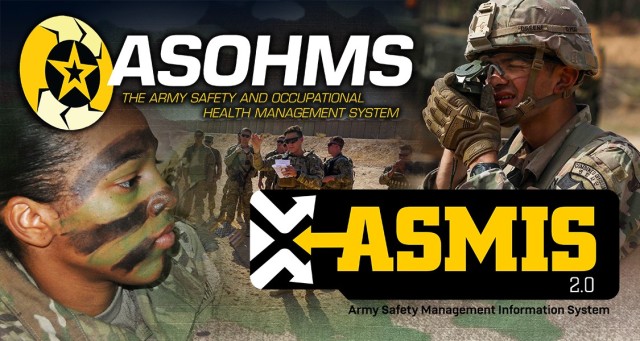The Army Safety Occupational Health Management System (ASOHMS) and Army Safety Management Information System (ASMIS) are synergistic. Synergistic is defined as two or more entities that can produce an effect greater than the sum of their individual effect. So, while both can exist alone, the effect of working the systems in conjunction will create a complete and whole safety management system.
There are some misnomers about the two systems that need to be dispelled.
- ASMIS is ASOHMS. No! As stated above, they complement and support each other.
- ASMIS is only about inputting mishap and near-miss reports. No! In fact, there are two other modules: the Inspections, Surveys and Assessment module (where the actual surveys being conducted are inputted) and the Hazards Management module (hazards identified and tracked for abatement). If we must input a mishap, then were the inspections or risk management being done and were hazards being controlled?
So, let’s talk about how the two are synergistic.
ASOHMS can be considered as the “human” side of the two. Army Regulation 385-10 and Department of Defense Instruction (DoDI) 6055.01 outline what is needed in our programs, but they don’t tell us how. ASOHMS has six core objectives that will ensure a competent safety program:
- Leadership Engagement and Personnel/Soldier Participation
- Investigate and Report Mishaps, Incidents and Illnesses
- Conduct Safety and Occupational Health Training and Promotion
- Conduct Inspections and Assessments
- Conduct Hazard Analysis and Develop Countermeasures
- Health Protection and Readiness
These objectives should be the focus of the safety manager to ensure they are providing a healthy and safe work environment. Safety managers should conduct the surveys, actively manage the hazard abatements, provide training to personnel, and investigate those near-misses or mishaps. ASOHMS is the qualitative aspect, meaning it is a way to measure, “Are they buying what you’re selling?”
ASMIS is the “IT” side of the two. It is the repository of all the “what” we do in managing our safety program. It’s a one-stop shop! That means no more finding the right folder on your desktop. What about the four Excel spreadsheets to keep up with inspections and hazards? Nope! ASMIS does all that for you and the Army as it standardizes inspections and hazard lists and, unfortunately, inputs our mishaps to find the root cause so they will not happen again. ASMIS is the quantitative aspect, meaning it is a way of measuring if the work is being done.
The proof is in the pudding. If you have 50 buildings that need to be inspected and you can see 30 have been done, what’s going on with the other 20? ASMIS allows the commander and safety professional to have the pulse on the SOH program with an accurate, up-to-date synopsis of the subordinate UICs at their fingertips.
“ASMIS was created to optimally meet the emerging needs of the Army,” said John Nelson, ASMIS director and U.S. Army Combat Readiness Center deputy chief of staff. “ASMIS 2.0 is built upon a modern platform that provides the foundation on which to field new capabilities incrementally. This means it will be able to adapt and grow well into the future to support the safety and occupational health requirement of the Army as a whole.”
In conclusion, when ASOHMS and ASMIS are used together, their synergism begins by feeding each other the pertinent information needed to have a well-rounded, accurate, robust safety system.
For more information, visit the U.S. Army Combat Readiness Center website at https://safety.army.mil.


Social Sharing